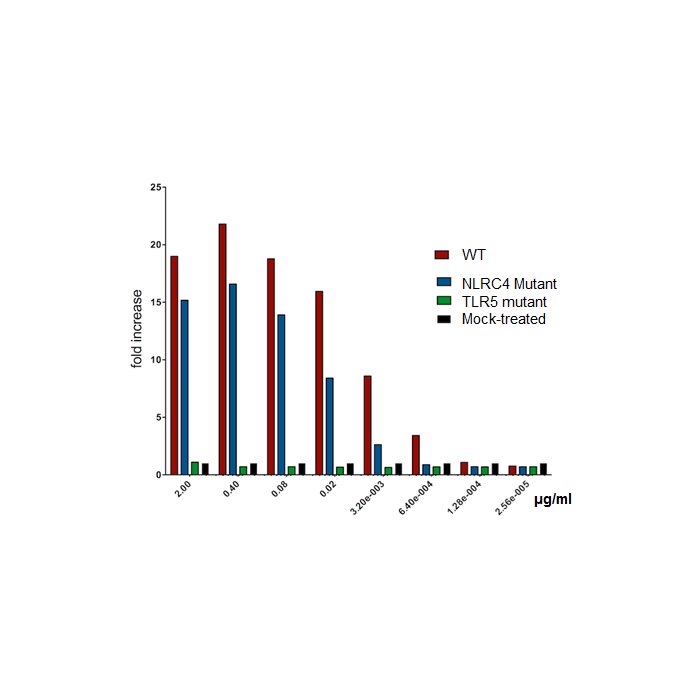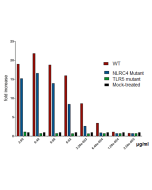Cookie Policy: This site uses cookies to improve your experience. You can find out more about our use of cookies in our Privacy Policy. By continuing to browse this site you agree to our use of cookies.
AdipoGen Life Sciences
Flagellin (NLRC4 Mutant) (rec.)

Method: Caco-2 cells transfected with plasmid encoding CCL20-LUC plasmid are activated for 24h with the indicated concentrations of Flagellin (rec.) (AG-40B-0125) and (NLRC4 Mutant) (rec.) (AG-40B-0126). As a negative control, Flagellin (TLR5 Mutant) (rec.) (AG-40B-0127) is used. Luciferase assays are performed on cell lysates and luminescence is normalized to mock-treated cells.
Method: Mice WT are injected i.v. with 1µg of Flagellin (rec.) (AG-40B-0125)(=WT) or Flagellin (NLRC4 Mutant) (rec.) (AG-40B-0126). After 2 hours, levels of CCL20 in the serum are measured by ELISA. As control, WT mice are injected i.v. with 1µg of Flagellin (TLR5 Mutant) (rec.) (AG-40B-0127). PBS injected mice are used as negative control.
Method: Bone-marrow mouse macrophages (BMDMs) from WT or NLRC4 -/- mice are either left untreated, or incubated with streptolysin (SLO), or SLO with Flagellin (rec.) (AG-40B-0125) (=WT), or SLO with Flagellin (rec.) (TLR4 Mutant) (AG-40B-0126) at the indicated concentrations for 10min. Macrophages are then washed and incubated further for 2h before the cell extracts are prepared and immunoblotted for caspase-1 activation. p10 or p20 fragments are detected using the anti-Caspase-1 (p10) (mouse), mAb (Casper-2) (AG-20B-0044) or the anti-Caspase-1 (p20) (mouse), mAb (Casper-1) (AG-20B-0042), respectively.
| Product Details | |
|---|---|
| Synonyms | FliC (NLRC4 Mutant) |
| Product Type | Protein |
| Properties | |
| Source/Host | E. coli |
| Sequence |
The native flagellin [FliC] from Salmonella enterica Serovar Typhimurium strain ATCC14028 (aa 1-495) contains a small deletion at the C-terminus of the protein required for NLRC4 activation and is fused at the N-terminus to a His-tag. |
| Crossreactivity |
Human Mouse |
| Specificity |
Detected by human and mouse TLR5 (Toll-like receptor 5). Not detected by mouse NLRC4 (Nod-like receptor [NLR] family caspase activation and recruitment domain [CARD] domain-containing protein 4). |
| Biological Activity |
Activation of TLR5 in human epithelial cell assays based on NF-κB luciferase fusions, in vivo on expression of CCL20 or IL-6. TLR5 can be stimulated in vitro by Flagellin (NLRC4 mutant) (rec.) at a concentration range of 5-50ng/ml and in vivo at a starting concentration of 0.1-1µg/mouse. Does not activate NLRC4 as tested in bone-marrow mouse macrophages (in the presence of streptolysin O (SLO)). It can be used as negative control for NLRC4 signaling. |
| Purity | ≥95% (SDS-PAGE) |
| Endotoxin Content | <0.01EU/μg purified protein (LAL test). |
| Concentration | 0.1mg/ml after reconstitution. |
| Reconstitution | Reconstitute with 100μl sterile water. |
| Formulation | Lyophilized. Contains PBS. |
| Other Product Data |
NCBI link NP_460912.1: Flagellin [Salmonella enterica subsp. enterica serovar Typhimurium str. LT2] |
| Shipping and Handling | |
| Shipping | BLUE ICE |
| Short Term Storage | +4°C |
| Long Term Storage | -20°C |
| Handling Advice |
After reconstitution, prepare aliquots and store at -20°C. Avoid freeze/thaw cycles. Centrifuge lyophilized vial before opening and reconstitution. |
| Use/Stability | Stable for at least 6 months after receipt when stored at -20°C. |
| Documents | |
| MSDS |
 Download PDF Download PDF |
| Product Specification Sheet | |
| Datasheet |
 Download PDF Download PDF |
Flagellin is the subunit protein which polymerizes to form the filaments of bacterial flagella. It activates the innate immune system through the receptor Toll-like Receptor 5 (TLR5) or the intracellular NLRC4 protein. The Flagellin (NLRC4 Mutant)(rec.) is only detected by TLR5 not by NLRC4.







